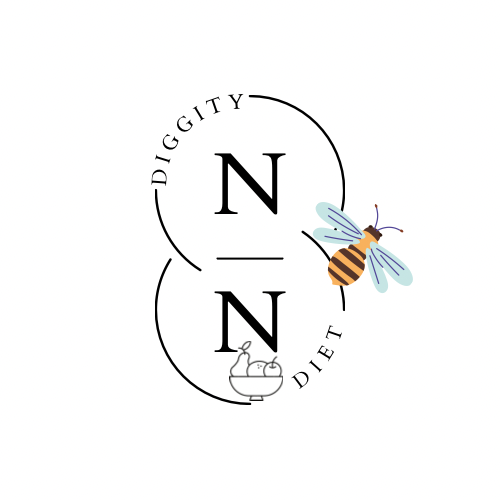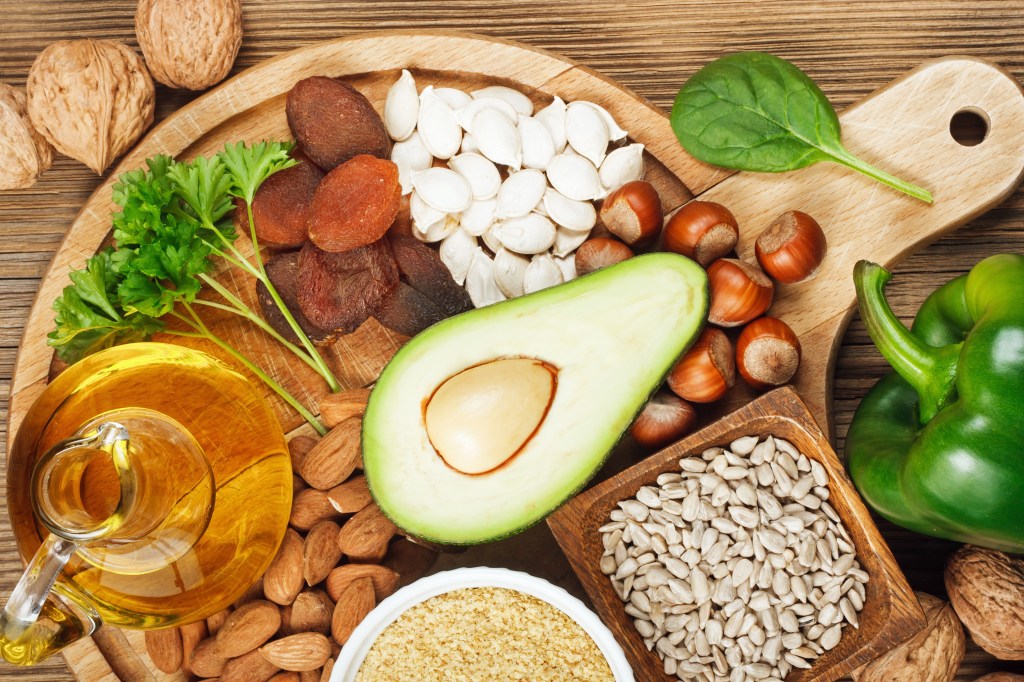Vitamin E was discovered in 1922 as a necessary dietary factor by Evans and Bishop firstly for reproduction in rats (17). Vitamin E is a collective term given to a group of fat-soluble compounds the main forms of the compound for humans are named alpha, beta, gamma and delta tocopherols, the major most abundant form is alpha (14). These compounds have been found to have antioxidant activities essential for health, vitamin E’s main antioxidant function is to stop and prevent oxidation of polyunsaturated fatty acids (14, 9). All forms of the vitamin are absorbed in the small intestine however the liver only metabolises alpha-tocopherol and excretes the other vitamin E forms (12). Vitamin E is a fat-soluble vitamin, which means it can be stored in fat tissue of animals and humans, therefore, does not have to be consumed every day as when levels are low the body will then turn to the stored vitamin E to compensate (14).
Vitamin E is present in naturally fat-containing foods, sources of vitamin E include vegetable oils, nuts, seeds, green leafy vegetables (e.g spinach), whole grains, and avocado (14, 9, 5, 8). Those that follow a Mediterranean diet are more likely to have higher vitamin E levels (8). Edible oils such as soybean, sunflower, corn walnut, cottonseed, palm, and wheat germ oils contain higher amounts of vitamin E compared to other oils (9). Vitamin E is a strange one as it has no specific recommendation for daily intake it is not clear what is considered the optimal recommended dietary allowance (RDA). However, currently, the RDA is just 15mg per day which is not much most people would get enough vitamin E from their daily diet (8). Babies from 0-6 months require 4mg, age 7-12 months 5mg, 1-3 years 6mg, 4-8 years 7mg, 9-13 years 11mg and from 14 upwards it is 15mg for both males and females (14). This rises to 19mg for lactating women, and it is assumed that demand in pregnant women for vitamin E may increase however this has been unproven (4).
Despite being a fat-soluble vitamin, there is not much documented evidence of toxicity from too much vitamin E, especially when obtained from food sources (14). Toxic effects do not show symptoms until levels of 1000mg are taken daily over a long period and these high doses are achieved through high supplementation (14, 8). Excessive supplementation or vitamin E intake can increase the risk of bleeding as this can interfere with blood clotting and cause thinning of the blood (16). Again, this will only happen if 1000mg or more is ingested daily however, drug interactions have been reported in patients with an intake of over 300mg of vitamin E a day which also causes blood to thin so those taking aspirin and warfarin should be careful it has also been found to interfere with tamoxifen (8, 16).
Vitamin E deficiency is rare in humans and will mostly be due to conditions or defects that would prevent the body’s ability to absorb the vitamin or dietary fat also those that have rare disorders of fat metabolism can be deficient (14). Symptoms of vitamin E deficiency include muscle weakness, vision problems, immune system changes, numbness, difficulty walking, tremors and poor sense of balance (14). Deficiency can lead to many issues such as neuromuscular problems, the loss of vibratory sensations, loss of positive Babinski reflexes and can even cause anaemia due to oxidative damage of red blood cells (10). Vitamin E deficiency is described as a progressive dying back of the nerves due to the vitamin’s connection to nerve function, these symptoms are similar to the abnormalities in those with Friedreich ataxia (17). Deficiency can also cause an impaired immune response.
So, what does vitamin E do for us? Vitamin E is a weird one because the exact function and the role it plays in diseases have been and continue to be debated (Rizvi et al., 2014). Vitamin E is mostly known for its antioxidant abilities, it prevents fat oxidation and prevents free radical reactions from occurring (14, 3). This is important so that the long-chain polyunsaturated fatty acids can maintain integrity in the membranes of cells which in turn maintains their bioactivity (17). Epidemiological studies have reported a correlation between a high intake of vitamin E and a reduced risk of cardiovascular diseases whereas antioxidants such as vitamin C and b-carotene did not however these were only found in two studies (3). The antioxidant effects of vitamin E have been reported to include beneficial effects for not only cardiovascular disease but also cancer, chronic inflammation, Alzheimer’s and Parkinson’s disease (4). There is a lot of contradiction around the function of vitamin E. Apart from the antioxidant effects, other believed functions include improvement in immune responses, therefore, protecting against several diseases (9). Possesses anti-cancer properties (14), regulation of gene expression, control of inflammation (5), increases cell division such as T cells increasing their percentage capable of being formed (9) and increases the resistance to viral diseases in the elderly (14). Vitamin E works well with vitamin C which can enhance the effectiveness of this vitamin, these two together have been found to play a beneficial role in diseases such as photodermatitis, menstrual pain/dysmenorrhoea, pre-eclampsia and tardive dyskinesia (6).
Athletes
Exercise is associated with the production of reactive oxygen species including free radicals as stress is put upon our bodies (1), this could mean that for those who exercise or especially athletes the demand for vitamin E may increase therefore the RDA of 15mg may not be sufficient enough (15). Antioxidants protect against oxidative stress therefore consuming antioxidants such as vitamin E can be beneficial for athletes and physically active people to combat fatigue and muscle damage (7). There is also convincing evidence that vitamin E status can help resist hypoxia and hyperoxia and deficiency can increase susceptibility to hypoxia and potentially lowers muscular performance therefore some athletes would supplement to prevent deficiency and possibly enhance performance (15). However, when supplementing with vitamin E due to being a fat-soluble mega dosage can increase the stores and potentially become toxic increasing the risk of bleeding and causing gastric distress (13). Supplementing with vitamin E has shown promise in two areas of athletic performance the first is for athletes training at altitude reducing red blood cell deformation however results remain inconclusive (2). The second is in acute supplementation which research has shown to improve performance during high-intensity exercise with short recovery periods and that supplementing with antioxidants is good for when immediate enhancement for performance is desired, however, this was not specifically vitamin E focused (11). On the other side of things supplementing with antioxidants may impair muscle hypertrophy and chronic supplementation has shown to impair athletic performance although many factors including the type of antioxidant, duration and type of exercise can affect the result of these studies (7). Overall, the results are mixed and not conclusive enough to advise athletes to supplement with vitamin E or any other antioxidants for performance-related outcomes (1).
Conclusion
Vitamin E is a strange one with no particular stand-out function and role however, we know it is an antioxidant and increasing the intake of antioxidants is beneficial to protect against a variety of diseases such as cardiovascular disease, cancer, chronic inflammation etc. The RDA for adults is currently set at 15mg however this may need to be increased for those who regularly take part in exercise and athletes. Vitamin E can help protect against fatigue therefore may be useful to supplement or increase dietary intake as a form of a performance enhancer. Due to being a fat-soluble too much vitamin E stored in the fat cells can become toxic however toxicity is very rare and is mostly impossible through diet alone toxicity will only happen with regular high dosage over some time. This remains an important vitamin for maintaining health and the benefits outweigh any negatives for the intake of vitamin E.
- Everything You Need to Know About Vitamin C
- Vitamin D and the Winter Months
- Everything You Need to Know About Vitamin K
- The Mediterranean Diet
- Everything You Need To Know About Vitamin E
References
- Beck, K., von Hurst, P., O’Brien, W. and Badenhorst, C. (2021) ‘Micronutrients and athletic performance: A review’. Food and Chemical Toxicology, 158 p.112618.
- Braakhuis, A.J.; Hopkins, W.G. (2015) Impact of dietary antioxidants on sport performance: A review. Sports Med. 45, 939–955.
- Brigelius-Flohe ́, R. and Traber, M. (1999) ‘Vitamin E: function and metabolism’. The FASEB Journal, 13 pp.1145-1155.
- Brigelius-Flohé, R., Kelly, F., Salonen, J., Neuzil, J., Zingg, J. and Azzi, A. (2002) ‘The European perspective on vitamin E: current knowledge and future research’. The American Journal of Clinical Nutrition, 76(4) pp.703-716.
- Dror, D. and Allen, L. (2011) ‘Vitamin E Deficiency in Developing Countries’. Food and Nutrition Bulletin, 32(2) pp.124-143.
- Food and Nutrition Board, (2000) Institute of Medicine . Dietary Reference Intakes for Vitamin C, Vitamin E, Selenium, and Carotenoids. Washington, DC: National Academy Press;.
- Higgins, M., Izadi, A. and Kaviani, M. (2020) ‘Antioxidants and Exercise Performance: With a Focus on Vitamin E and C Supplementation’. International Journal of Environmental Research and Public Health, 17(22) pp.1-26.
- Kemnic, T. and Coleman, M. (2021) ‘Vitamin E Deficiency’. National Library of Medicine, 1(1).
- Lee, G. and Han, S. (2018) ‘The Role of Vitamin E in Immunity’. Nutrients, 10(1614) pp.1-18.
- Li D, Saldeen T, Romeo F, Mehta JL. (1999) Relative effects of alpha-and gamma-tocopherol on low-density lipoprotein oxidation and superoxide dismutase and nitric oxide synthase activity and protein expression in rats. J Cardiovasc Pharmacol Ther.;4:219–26.
- Merry, T.L.; Ristow, M. (2016) ‘Do antioxidant supplements interfere with skeletal muscle adaptation to exercise training?’ J. Physiol. 594, 5135–5147.
- Owen, K. and Dewald, O. (2022) ‘Vitamin E Toxicity’. National Library of Medicine, 1(1).
- Powers, S.K.; Sollanek, K.J.; Wiggs, M.P. (2014), ‘Endurance Exercise and Antioxidant Supplementation: Sense or Nonsense?—Part 2’. Sports Sci. 27, 1–4.
- Rizvi, S., Raza, S. T., Ahmed, F., Ahmad, A., Abbas, S., & Mahdi, F. (2014). The role of vitamin e in human health and some diseases. Sultan Qaboos University medical journal, 14(2), e157–e165.
- Sharman, I., Down, M. and Sen, R. (1971) ‘The effects of vitamin E and training on physiological function and athletic performance in adolescent swimmers’. British Journal of Nutrition, 26(2) pp.265-276.
- Shoemaker, S. (2020) Vitamin E Overdose: Symptoms, Side Effects, and Treatment. Healthline. [Online] [Accessed on 16 June 2022] https://www.healthline.com/nutrition/vitamin-e-overdose#side-effects-symptoms.
- Traber, M. and Atkinson, J. (2007) ‘Vitamin E, antioxidant and nothing more’. Free Radical Biology and Medicine, 43(1) pp.4-15.


Leave a comment